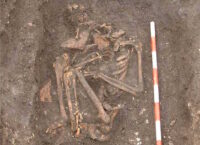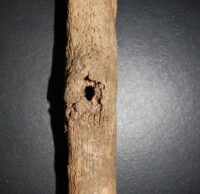Analysis of a skeleton found buried inside a medieval church has identified the deceased as a reclusive  anchoress from the mid-15th century with late-stage syphilis. The burial was unearthed during a 2007 excavation of the cemetery and former All Saints Church in advance of redevelopment. Very little is known about the church. The earliest reference to it dates around 1095 and records the church being given to the monastery of Whitby Abbey. The church died with the abbey in 1539, victim to Henry VIII’s dissolution of the monasteries, and over time the exact location was lost. Construction of a cattle market on the site in the 1820s encountered numerous human bones, but they weren’t documented.
anchoress from the mid-15th century with late-stage syphilis. The burial was unearthed during a 2007 excavation of the cemetery and former All Saints Church in advance of redevelopment. Very little is known about the church. The earliest reference to it dates around 1095 and records the church being given to the monastery of Whitby Abbey. The church died with the abbey in 1539, victim to Henry VIII’s dissolution of the monasteries, and over time the exact location was lost. Construction of a cattle market on the site in the 1820s encountered numerous human bones, but they weren’t documented.
Given the cattle market history, the 2007 excavation was expected to run into burials from the cemetery and maybe even some architectural remains of the medieval church. They found more than they expected — inhumation and cremation burials going back to the Roman era, more than 500 medieval burials, ten post-medieval mass graves and the cobble and rubble foundations of the masonry church. A total of 547 medieval burials were found inside the church and outside of its walls extending into the former churchyard. The mass burials contained more than 100 bodies in total, probably the casualties of disease during the 1644 Siege of York in the English Civil War.
On the east side of the large rectangular nave was a smaller rectangular chancel with a semi-circular apse at the end. Archaeologists discovered an unusual burial in the apse: a middle-aged woman in tightly crouched position. The hundreds of other burials at the site were positioned with bodies extended, as was typical of medieval Christian burial. SK 3870 must have been someone of high status to warrant so large a grave inside the apse of the church, but a church patron would not typically be buried in a crouch posture.
Historical evidence and the archaeological record of this burial indicate it belonged to Lady Isabel German, a 15th century anchoress. Anchoresses (or anchorites if they were men) chose to live an ascetic life of religious contemplation literally walled into a small cell, usually attached to the side of the church. Religious enclosure was considered a holy vocation and anchorites and anchoresses were treated like living saints. In medieval England, the practice was increasingly popular, going from 96 documented anchorites at 77 sites in the 12th century to a peak of 204 at 129 sites in the 15th century. Archaeological evidence of anchorites and achoresses is rare, and usually takes the form of structural remains of the anchorhold, not the osteological remains of the anchoress. Only one other confirmed anchoress burial is known (at St. Anne’s church in Lewes, Sussex).
Lady Isabel lived inside her tiny room for 20 years from 1428 to 1448, her only contact with the world through two small curtained windows, one in the outer wall of the cell, one in the interior wall. She listened to mass and received food through the interior window. Parishioners would come to the exterior window seeking advice and prayer.
 Osteological analysis found that she was between 30 and 50 years old when she died. She had osteoarthritis and severe osteoporosis, a condition that may have been connected to her lack of movement in the extremely confined space of her cell. She also bore the lesions of advanced stage syphilis all over her body — the bones of her chest, shoulders, both arms, hands, pelvis, both legs, feet. The combination of these serious illnesses would have rendered her all but immobile.
Osteological analysis found that she was between 30 and 50 years old when she died. She had osteoarthritis and severe osteoporosis, a condition that may have been connected to her lack of movement in the extremely confined space of her cell. She also bore the lesions of advanced stage syphilis all over her body — the bones of her chest, shoulders, both arms, hands, pelvis, both legs, feet. The combination of these serious illnesses would have rendered her all but immobile.
Given the severity of the pathological lesions exhibited by SK 3870, [rigor mortis of the corpse in the position at death] could explain her unusual burial position, or perhaps it was also the position she was forced to adopt in life because of her illness, perhaps as a consequence of pain from severe disease in multiple joints and extensive infection.
Alternatively, the body could have been positioned like this in order to fit the grave, though it is unclear why the grave should be so wide and short compared to a typical contemporary grave made to accommodate an extended and supine burial. One possible explanation may be that the grave was dug in available space within the apse, perhaps between heavy or immovable objects or furniture which prevented the excavation of a grave appropriate for an extended individual.